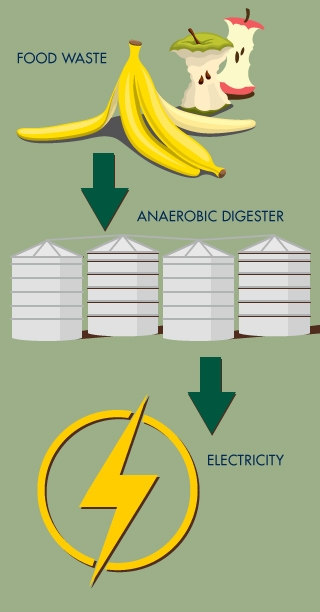Biodigester turns campus waste into campus energy
Last week, on Earth Day, the university and Sacramento-based technology partner CleanWorld unveiled the UC Davis Renewable Energy Anaerobic Digester (READ) at the campus' former landfill. Here, the anaerobic digestion technology Zhang invented is being used inside large, white, oxygen-deprived tanks. Bacterial microbes in the tanks feast on campus and community food and yard waste, converting it into clean energy that feeds the campus electrical grid.
“This technology can change the way we manage our solid waste,” Zhang said. “It will allow us to be more economically and environmentally sustainable."
It is the third commercial biodigester CleanWorld has opened using Zhang's technology within the past two years and is the nation's largest anaerobic biodigester on a college campus.
The system is designed to convert 50 tons of organic waste to 12,000 kWh of renewable electricity each day using state-of-the-art generators, diverting 20,000 tons of waste from local landfills each year. It is expected to reduce greenhouse gas emissions by 13,500 tons per year.
The READ BioDigester encompasses several of the university's goals: reducing campus waste in a way that makes both economic and environmental sense, generating renewable energy, and transferring technology developed at UC Davis to the commercial marketplace.
The biodigester will enable the more than 100 million tons of organic waste each year that is currently being landfilled in the U.S. to be converted to clean energy and soil products. The READ BioDigester is a closed loop system, moving from farm to fork to fuel and back to farm. Whatever is not turned into biogas to generate renewable electricity can be used as fertilizer and soil amendments — 4 million gallons of it per year, which could provide natural fertilizers for an estimated 145 acres of farmlands each day.
Nearly half of the organic waste, or feedstock, needed to operate the biodigester to full benefit will come from UC Davis dining halls, animal facilities and grounds. CleanWorld is working with area food processing and distribution centers to supply the remaining amount. Meanwhile, UC Davis will earn 100 percent of the project's green energy and carbon credits and receive all of the electricity generated.
Anaerobic digestion is an age-old process. However, Zhang's patented technology made it more efficient — capable of eating a broader variety and bigger quantity of waste, turning it into clean energy faster and more consistently than other commercial anaerobic biodigesters.
View a video about the UC David biodigester here:
(This blog post is condensed from a UC Davis news release about the biodigester.)
Additional information:
- Read the full press release
- Download biodigester photos
- Vine video: From lunch to lights
- Visit http://www.cleanworld.com/


If I understood things correctly, what seems to make it work economically is that it is located at the landfill, so they are using the EXISTING gas scrubbing technology to clean the gas and and an EXISTING microturbine (which already has a CARB emissions certificate) to burn the gas. The marginal cost to do biogas in these circumstances is low because they are leveraging existing, paid-for infrastructure and taking advantage of unused capacity in their landfill gas generation, which makes sense since landfills generate less gas as time goes on.
It seems that the conclusion that one should draw is that biogas generation from digesting organic waste makes good sense if you run it at a landfill (in that the waste collection and sorting and gas cleanup and combustion infrastructure are already in place) and if you have a farm nearby that will supply animal waste to feed the digester and which will use the leftovers from the anaerobic digestion as fertilizer. Under those conditions, they may have found a sustainable, assumedly cost-neutral way of generating biogas.
The video/press release seems to imply that biogas is, in general, a sustainable, cost-neutral method for producing renewable energy and that this project is a model for what could be adopted all over the country. It is probably not that. This doesn't take anything away from the unique set of circumstances that have been assembled at UC Davis and the clever, thoughtful folks who have put these circumstances together. I just wish that they would point out that this set of circumstances is hardly typical.
Posted by Phillip Wolf on April 30, 2014 at 2:28 PM